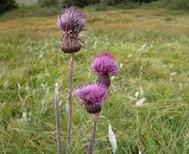 Thistle is an annual plant that is characterized by having large leaves and thorns . Thistles (a term that comes from the Latin word cardus ) are part of the group of compound or asteraceae plants, whose flowers appear as compound inflorescences surrounded by bracts.
Thistle is an annual plant that is characterized by having large leaves and thorns . Thistles (a term that comes from the Latin word cardus ) are part of the group of compound or asteraceae plants, whose flowers appear as compound inflorescences surrounded by bracts.
Because it is a colloquial language concept, in any case, plants from different genera and families are known as thistle. Cylindropuntia rosea , for example, is called thistle. This plant is found in deserts of Mexico and the United States .
The species Carduncellus monspelliensium , Carthamus lanatus and Cirsium echinatum , among many others, are also called thistles. That is why it is important to keep in mind that talking about thistles is referring to many different plants, with common characteristics but also with multiple differences.
There are edible thistles , such as Cynara cardunculus . The roots, stems and flowers of this thistle can be prepared in different ways. It is a food rich in water , with a small amount of fats, proteins and carbohydrates.
In the same way as artichokes, thistle is a very beneficial food for our health , especially for taking care of the gallbladder and liver. Both are highly rich in cynarin, a cholerectic component, meaning its properties promote the production of bile, ideal for improving digestion and avoiding a series of problems that arise from poor digestion, such as intestinal acidity, heaviness and the gases.
Another of the medicinal properties of thistle is that it reduces the risk of fluid retention . Thanks to its acids (especially caffeic, ascorbic and chlorogenic), cynarin and calcium, this food makes the body feel the need to urinate. These components are very useful in situations and conditions such as obesity, rheumatism, kidney stones, high blood pressure, premenstrual syndrome disorders and excess uric acid.
To lose weight, thistle also has benefits worth highlighting, as mentioned slightly above. In addition to promoting digestion and diuresis, its calorie content is very low, approximately half that of artichokes, which combines with its high percentage of water and potassium to provide an ideal formula against abnormal weight gain. .
 On the other hand, many specialists recommend this food to complement diabetes treatment . And thistle has a polysaccharide called inulin that helps lower blood sugar levels. Other vegetables from the Compositae family also have this component; three examples are garlic, onion and chicory, and they are used for the production of fructose.
On the other hand, many specialists recommend this food to complement diabetes treatment . And thistle has a polysaccharide called inulin that helps lower blood sugar levels. Other vegetables from the Compositae family also have this component; three examples are garlic, onion and chicory, and they are used for the production of fructose.
As if all this were not enough, inulin also promotes the absorption of calcium and helps reduce cholesterol levels, making it ideal for preventing osteoporosis, breast and colon cancer, in addition to increasing the intestinal transit and prevent constipation. Likewise, this component of edible thistle has bifidogenic properties, that is, it stimulates the increase of bacteria that benefit the intestine.
In the time of the Roman Empire , a cardo was a street that oriented from north to south. The Cardō Maximus was the most important cardo in a colony or camp, which intersected with another very important street: the Decumanus Maximus .
Also in Roman times, there was a divinity known as Cardo , Cardinea or Cardea . According to mythology , Cardo was a goddess linked to health and the wind.
